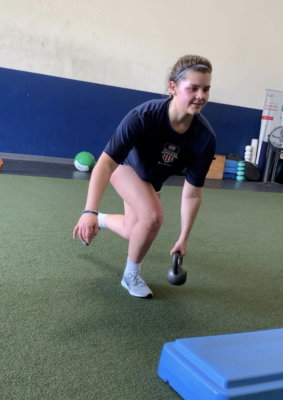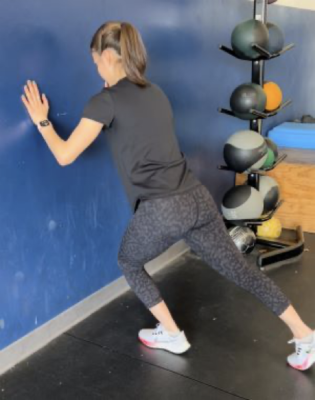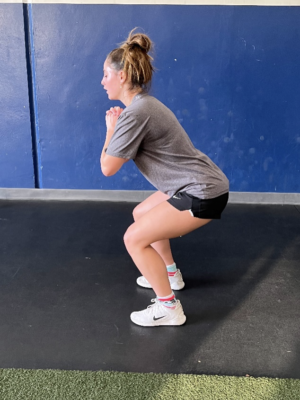Soccer is a leg and lower body dominant sport featuring kicking, running, jumping and slide tackles. So, it should be no surprise that most soccer injuries seen involve the lower body (unless you are a goalkeeper).
The knees are central to most soccer skills, and as players enter teenage years, knee injuries are the most common joint injury followed closely by the ankles. Abnormal ankle mobility can not only cause pain and injury but can also limit ability to get in certain soccer-specific positions.
Read on for expert sports medicine tips to protect knees and ankles to keep your favorite soccer player(s) on the field.
ACL (Anterior Cruciate Ligament aka “All too Common Ligament” Injuries)
Let’s start with the big one, the serious type of knee injury that can keep players off the field for up to a year if not longer. The Anterior Cruciate Ligament (ACL) connects the thigh bone to the shin bone in the center of the knee and provides stability with landing from jumps or changing direction.
ACL injuries can occur from direct contact to the knee, but especially with adolescent female soccer players, non-contact awkward single-leg cuts, turns or landings are often the culprit for ACL tears.
Defensive tackling (often with a sidestep movement) to reach out to separate an opponent from the ball and cutting to track an opponent have been shown as key potential risk factors for ACL injury.
Not only are ACL tears immediately painful, they can also cause problems years after the original injury.
Tears to other ligaments or of the menisci (shock absorbing pads on the inside and outside of the knee) often come with ACL tears. Most players who tear an ACL and want to return to soccer will require surgical repair and a prolonged recovery period that often takes at least 9-12 months after surgery.
Even after that extended rehabilitation, a return to soccer increases the risk (by 25-33%) of another ACL tear to either the injured or non-injured knee. Whether or not a player returns, having an ACL tear carries a close to 50% risk of early arthritis (knee joint breakdown) within 10-20 years after the injury. (Nicole A Friel, 2013) That’s a lot of relatively young 30 somethings maybe needing knee joint replacement surgery.
With all this doom and gloom, there is a glimmer of good news on the ACL front. There are practical and proven ways to reduce non-contact ACL injuries.
If you have 10-15 minutes, you have the time to complete a proper evidence-based ACL Injury Prevention Program Yes, a mere 10–15-minute investment 3 times a week can help reduce a major injury, major rehab period and major risk of arthritis. Then we’ll throw the bonus of increasing strength and efficiency of running and jumping.
Utilizing the following three exercises will improve strength, nerve/muscle control, and landing technique to allow lower leg muscles to absorb energy when the foot hits either the box or ground. They are three simple and safe exercises that can be performed by most athletes. The key is proper mechanics.
- Box Jump 2 to 1: Utilizing a 6-inch box or step, squat down with two legs and jump up to the box landing on one leg. Upon landing, the athlete needs to shock absorb flexing (bending) at the hip, knee, and ankle. The knee also must stay below the hip and without any valgus or inward movement of the knee.
- Lateral Depth Jump 2 to 1: Begin standing on a 6-inch box or step and jump laterally landing on one foot. Upon landing, the athlete needs to shock absorb flexing at the hip, knee, and ankle. The knee also must stay below the hip and without any valgus or inward movement of the knee.
- Single Leg Squat: standing on one leg and squatting down until your thigh is just above parallel to the ground. Maintain good form with hips back, chest forward and knee beneath your hip and not moving inward.

Kneecap (Patella) Instability
Any disruption to how the kneecap communicates with the thigh bone can lead to knee pain during running, jumping, and kicking.
The most dramatic type is called a patellar dislocation where the kneecap comes completely out of usual position and can be found on the outside of the thigh bone. Sometimes the kneecap can be repositioned on the field with a particular relocation movement, while other cases require an emergency room visit and special medication to relax the knee (and patient).
The kneecap can also partially come out of joint toward the outside of the thigh bone. This is known as a patellar subluxation. This abnormal motion can occur on a recurrent basis and lead to lasting episodes of pain and limited bending/straightening of the knee.
The odds of increased abnormal kneecap motion (aka patellar laxity) can be reduced by learning the same landing and cutting skills taught in those ACL Injury reduction programs as well as strengthening the vastus medialis or the quadricep muscle towards the inside of the knee.
When seeing players with kneecap instability (and we recommend specialist sports medicine evaluation for any type of patellar laxity problems), we look at things like increased motion in other joints, abnormal muscle function in the front and outside of the knee, and single-leg squat technique.
Treatments can include strengthening exercises for hip and quadriceps along with stretching of muscle groups. Knee sleeve braces with padding/support for the outside of the kneecap can help. Some soccer players find them too bulky for quick movements while others want to wear one on each knee (so opponents must guess about the injured knee).
Anterior Knee Pain
Yes, patellar instability is indeed one cause of pain in the front of the knee, but there are several other flavors that affect soccer players.
Younger players who haven’t reached full adult height commonly report pain at growth regions (aka the apophyis) of the top of the shin bone (tibial tubercle) and lower part of the patella. Osgood-Schlatter is the medical name for irritation of the tibial tubercle while pain at the lower patella is known as Syndig-Larson-Johansson syndrome.
The diagnosis is straight forward. The athlete uses a fingertip to point out the location of pain with local swelling, usually with more of a gradual onset. A prominent bump may be seen at the tibial tubercle on the shin bone just below the knee joint. That bump may go away after growth is finished, but not always.
Once a player ends growth, we see more issues with the patellar tendon (connects the 4 quadricep muscles in the front of the thigh through the kneecap to attach at the shin bone) or more general patellofemoral pain between kneecap and thigh bone.
Relative weakness of the muscles behind the hips and upper thigh as well as hamstring tightness can contribute to excessive forces in the front of the knee. Once again, those same ACL injury prevention exercises as discussed previously can also reduce other forms of anterior knee pain.
Ankle Sprains
Let’s switch the focus to ankles, where sprains are a most common type of injury. The great majority of ankle sprains are from rolling the ankle inward (aka inversion) and involve injury to the support ligaments on the outside of the joint.
Much like knee injuries, ankles sprains in soccer tend to occur after landing from a jump or changing direction. Thus, it should be no surprise that exercises that emphasize strength of the upper leg (hip/buttock) muscles (such as those box/lateral jumps) and focus on good single-leg squat alignment can reduce ankle sprains.
There is also no doubt that past ankle sprains are a major risk factor for future ankle sprains. Cutting short a rehab program and trying to return too quickly often leads to future injury. The best way to reduce a repeat ankles sprain is to complete a rehab program and continue with maintenance ankle/leg exercises once back on the field.
Ankle Tightness and Limited Motion
Appropriate mobility of the ankle joint is the ability to move through a range of motion both unloaded and loaded. In other words, an athlete may be able to gain certain range of motion while sitting down, but can they do it while performing important soccer motions such as jumping, landing, or pushing off?
The soleus and gastrocnemius are two major muscles in the back of the calf/shin that affect ankle mobility. Both muscles plantarflex the ankle (push toes away from shin) as in performing a calf raise or sprinting and jumping during soccer. The big difference between the two is that the soleus originates below the knee whereas the gastrocnemius originates above the knee. Knowing this is important, because the athlete will need to stretch the ankle with both the knee bent (focus on soleus) and straight (focus on gastrocnemius).
Two simple steps that can be taken to reduce ankle injuries and increase performance include:
- For the soleus, stand six inches from the wall and see if the athlete can touch their knee to the wall with the knee flexed and keeping the foot flat on the ground and facing the wall.
- For the gastrocnemius, place the foot behind you and flat on the ground with the athlete’s knee straight this time. See if the athlete can get their knee over their toe while maintaining a flat foot and straight knee.

There is a myth that you should never get your knees over your toes with sport or training activities. However, look at most athletes when they run, cut, and jump. The knee slightly or sometimes extremely goes over the toes. When performing simple movement patterns such as squats or lunges, the knees need to go slightly over the toes to engage leg and hip/pelvis muscles to maximize performance. It is key that knees are slightly over the toes with the shin angle and trunk ankle being parallel. The force should go through the mid foot and not the heel.

When dealing with ankle or knee problems, or any soccer related injury, it is important to make sure the healthcare provider is addressing each piece of the rehab picture. Treatment should look at the whole body and not just the injured area. The goal should always be not just to return an athlete quickly to the field, but as safely as possible to reduce risk of repeat or new injuries. Taking the time to complete an exercise program can also increase running and jumping performance and endurance.
Dr. Chris Koutures is a dual board-certified pediatric and sports medicine specialist who practices at ActiveKidMD in Anaheim Hills, CA. He is a team physician for USA Volleyball (including participating in the 2008 Beijing Olympics), the U.S. Figure Skating Sports Medicine Network, Cal State Fullerton Intercollegiate Athletics, and the Chapman University Dance Department.. He offers a comprehensive blend of general pediatric and sport medicine care with an individualized approach to each patient and family. Please visit activekidmd.com or follow him on Facebook (https://www.facebook.com/activekidmd/), Instagram (https://www.instagram.com/activekidmd/), or Twitter (@dockoutures).
Chris Phillips is an Athletic Trainer, Strength and Conditioning Specialist and Sports Safety Specialist with over 30 years’ experience in professional hockey, football, dance, cheerleading, and soccer. Chris has worked with hundreds of professional, Olympic and Hall of Fame athletes and is the owner of Compete Sports Performance and Rehab in Lake Forest, California. He most recently worked with the figure skaters at the Winter Olympics in Beijing. For more information, visit https://competeperformance.com,or follow him on Facebook (https://www.facebook.com/CompeteSportsPerformance), Instagram (https://www.instagram.com/competesportsperformance/), or Twitter (@competesportspr).
Works Cited
Nicole A Friel, M. a. (2013, January). National Center for Biotechnology Information. Retrieved from National Library of Medicine: https://www.ncbi.nlm.nih.gov/pmc/articles/PMC6548436/

